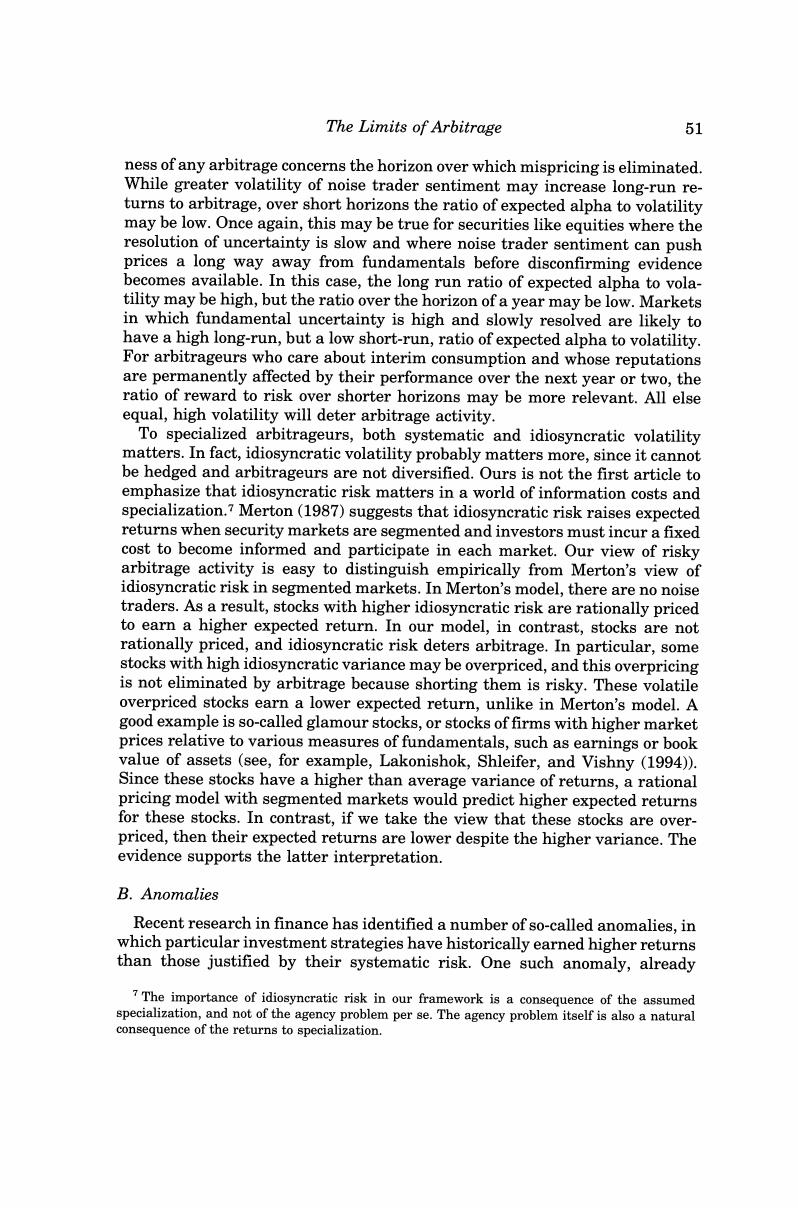正在加载图片...

The Limits of Arbitrage 51 ness of any arbitrage concerns the horizon over which mispricing is eliminated. While greater volatility of noise trader sentiment may increase long-run re- turns to arbitrage,over short horizons the ratio of expected alpha to volatility may be low.Once again,this may be true for securities like equities where the resolution of uncertainty is slow and where noise trader sentiment can push prices a long way away from fundamentals before disconfirming evidence becomes available.In this case,the long run ratio of expected alpha to vola- tility may be high,but the ratio over the horizon of a year may be low.Markets in which fundamental uncertainty is high and slowly resolved are likely to have a high long-run,but a low short-run,ratio of expected alpha to volatility. For arbitrageurs who care about interim consumption and whose reputations are permanently affected by their performance over the next year or two,the ratio of reward to risk over shorter horizons may be more relevant.All else equal,high volatility will deter arbitrage activity. To specialized arbitrageurs,both systematic and idiosyncratic volatility matters.In fact,idiosyncratic volatility probably matters more,since it cannot be hedged and arbitrageurs are not diversified.Ours is not the first article to emphasize that idiosyncratic risk matters in a world of information costs and specialization.?Merton(1987)suggests that idiosyncratic risk raises expected returns when security markets are segmented and investors must incur a fixed cost to become informed and participate in each market.Our view of risky arbitrage activity is easy to distinguish empirically from Merton's view of idiosyncratic risk in segmented markets.In Merton's model,there are no noise traders.As a result,stocks with higher idiosyncratic risk are rationally priced to earn a higher expected return.In our model,in contrast,stocks are not rationally priced,and idiosyncratic risk deters arbitrage.In particular,some stocks with high idiosyncratic variance may be overpriced,and this overpricing is not eliminated by arbitrage because shorting them is risky.These volatile overpriced stocks earn a lower expected return,unlike in Merton's model.A good example is so-called glamour stocks,or stocks of firms with higher market prices relative to various measures of fundamentals,such as earnings or book value of assets (see,for example,Lakonishok,Shleifer,and Vishny(1994)). Since these stocks have a higher than average variance of returns,a rational pricing model with segmented markets would predict higher expected returns for these stocks.In contrast,if we take the view that these stocks are over- priced,then their expected returns are lower despite the higher variance.The evidence supports the latter interpretation. B.Anomalies Recent research in finance has identified a number of so-called anomalies,in which particular investment strategies have historically earned higher returns than those justified by their systematic risk.One such anomaly,already 7 The importance of idiosyncratic risk in our framework is a consequence of the assumed specialization,and not of the agency problem per se.The agency problem itself is also a natural consequence of the returns to specialization